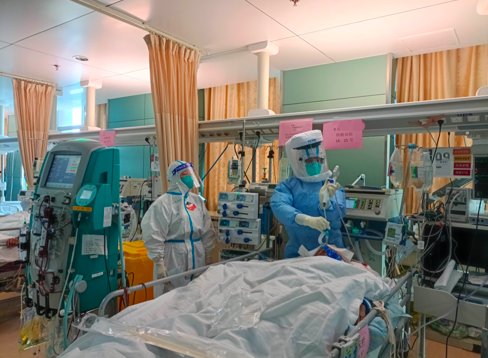
There is good news from the new crown intensive care ICU ward of Gongli Hospital, Pudong New Area, Shanghai: a leukemia patient infected with the new crown virus after bone marrow transplantation Critically ill patients, after 23 days of “artificial heart and lung” – extracorporeal membrane oxygenation (ECMO) and other comprehensive treatment, their heart and lung function improved, and ECMO was successfully removed yesterday!
On the evening of May 7th, the speed of life and death was staged in the new crown intensive care unit of Gongli Hospital. Mr. Liu (pseudonym), a severe new crown patient in February after leukemia bone marrow transplantation, developed severe breathing due to the deterioration of his condition. , circulatory failure, pericardial effusion and renal damage.
On ECMO! After consultation between the Zhejiang Intensive Care Medical Team and the Gongli Hospital expert group, the patient was given emergency venous-arterial (VA-ECMO) treatment that night.
On May 9, after the bedside rounds of the national supervision expert group, they fully recognized and affirmed the medical measures taken by the medical team at the first time, and at the same time combined the patient’s current hemodynamics and respiratory mechanics Constructive comments are given for the changes: adjustment to venous-arterial-venous (VAV-ECMO) mode.
Soon, the patient’s oxygen and condition and heart rate became more stable. According to the information of various experts, this is a very rare VAV-ECMO treatment for new crown treatment since the domestic epidemic.
Since then, in order to promote the patient’s pulmonary drainage, pulmonary recruitment, and improve lung compliance, the “Zhejiang” nursing team overcomes all difficulties and implements prone position ventilation on the patient with tubes inserted all over the body. At the same time, according to the theory of “lung and intestine treatment” in traditional Chinese medicine, multi-channel medicines such as oral administration of traditional Chinese medicine, enema, and hot ironing are used to improve intestinal wall edema and gastrointestinal motility to promote the recovery of lung function.
Under the joint efforts of the national and municipal expert groups and the medical team in the ward, the patient’s condition gradually improved. The left femoral artery catheter was successfully removed on the evening of the 19th, and the transition to venous-venous (VV-ECMO) mode was established. .
On the morning of the 30th, the medical team worked together to successfully evacuate the patient from ECMO and successfully removed the vascular catheter!
Guo Dongfeng, director of the emergency department of Gongli Hospital, introduced that ECMO is an emergency equipment used for extracorporeal respiration and circulation support in critically ill patients with refractory circulation and respiratory failure. Blood is drawn, hemoglobin flows through the membrane lung to oxygenate and remove carbon dioxide, and then the oxygenated blood is returned to the patient. In other words, ECMO is to temporarily “replace” the overwhelmed lungs, allowing the patient to “survive” and buying time for the recovery of heart and lung function.
Complications such as bleeding, embolism, and infection may occur at any time during the operation of ECMO, and any accident may be fatal. Therefore, being able to help patients recover their damaged cardiopulmonary function in the shortest possible time and wean them off in a timely manner is the biggest challenge faced by the rescue team.
Up to now, including this patient, nearly 50 severe and critically ill patients with new coronary pneumonia have been treated in the New Crown Intensive ICU ward of Gongli Hospital, with an average age of nearly 80 years old and multiple underlying diseases. , most of whom have been discharged.
Author: Tang Wenjia Wu Ruilian
Editor: Tang Wenjia< /p>
Responsible editor: Fan Liping
*Wenhui’s exclusive manuscript, please indicate the source for reprinting .